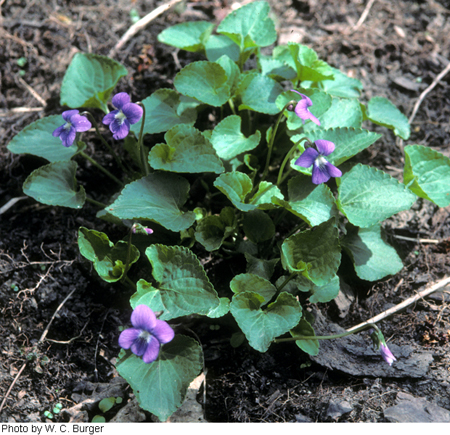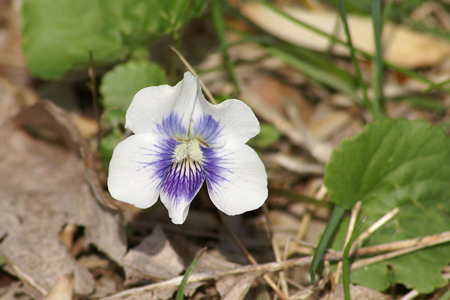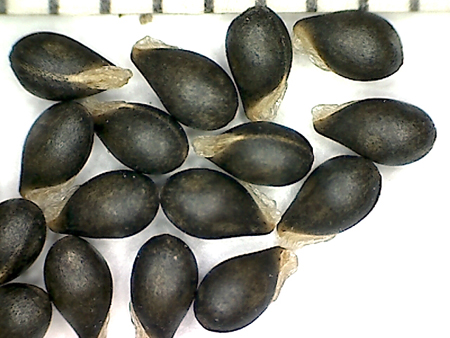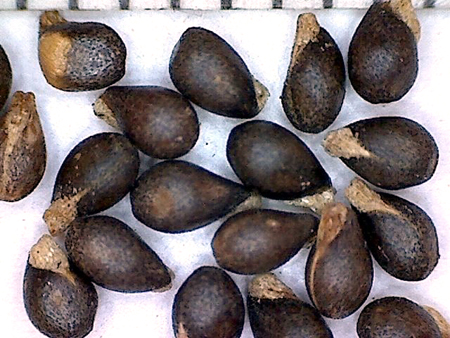Viola communis Pollard
Common names:
Common Blue Violet, Confederate Violet, Dooryard Violet, Hooded Blue Violet, Meadow Violet
Synonyms:
See subordinate taxa.
Subordinate taxa belonging to this species:
Viola communis f. communis
Viola communis f. priceana (Pollard) H.E.Ballard, comb. ined.
Description:
Acaulescent rosulate perennials from thick rhizome, ≤ 20 cm tall; foliage and peduncles deep green, both surfaces of leaf blades glossy, lower surface occasionally purple-tinged, glabrous or upper surface of leaf blades with scattered minute appressed hairs (may need handlens); stipules free, irregularly glandular-fimbriate; leaves spreading, leaf blades undivided, largest ≤ 92 × 92 mm, in spring suborbicular or broadly deltate-ovate, in summer broadening to deltate-reniform, base cordate to shallowly cordate, margins closely and uniformly crenate-serrate to the broadly obtuse (rarely broadly acute) to rounded apex, eciliate; chasmogamous peduncles held among the leaves (sometimes above the leaves in regularly mowed lawns and roadsides); chasmogamous flower ≤ 21 mm; calyx eciliate; lowest sepals lance- to ovate-triangular, acuminate; auricles prominent, usually erose, weakly elongating in fruit to 2 mm; corolla blue to purple, or white with a broad blue-gray eyespot surrounding the throat formed from coalescing nectarguide-lines (f. priceana), throat white; spur short-globose; lateral petals densely bearded with filiform to slightly clavate hairs, spurred petal glabrous; cleistogamous flowers produced after chasmogamous, on prostrate and curved or coiled peduncle gradually elongating to become upright and sinuous-straight but shorter than petioles (held among or above the leaves in mowed or disturbed sites); cleistogamous capsule 8–12 mm, green drying tan, unspotted or with fine to heavy purple spots or blotches, glabrous; seeds 1.5–2.5 × 0.9–1.5 mm, olive- or brownish-black to blackish seeds, commonly with minute raised black spots.
Similar species:
The undivided deep green essentially glabrous glossy orbicular to broadly deltate-ovate or deltate-reniform leaf blades with margins closely and uniformly crenate, apex broadly obtuse to rounded, render this species unmistakable. It is most similar to Borealiamericanae taxa with glabrous foliage and leaf blades as broad as or broader than long, as well as species with leaf blades broadening substantially in fruit. Besides the vegetative features noted above, this species differs in chasmogamous flower from V. nephrophylla in its glabrous spurred petal, sepals with acute apices and prominent auricles; and from V. domestica, V. sororia [glabrous variant] and V. sororia [hirsutuloides variant] in its shorter stature, ovate-triangular sepals acuminate from the middle, and prominent auricles. Viola communis f. communis differs from V. cucullata in the flowers held among the leaves, ovate-triangular sepals acuminate from the middle, blue to purple corolla lacking a conspicuously contrasting eyespot around the throat, and lateral petal beards with long filiform to slightly clavate hairs concealing the throat; f. priceana shares a conspicuously contrasting eyespot around the throat with V. cucullata but diverges in its usually white to very pale violet petals, as well as the other traits mentioned for f. communis. In cleistogamous fruit, it can be separated from V. affinis and V. missouriensis in its often unspotted cleistogamous capsule on gradually erect-sinuous peduncle, ovate-triangular acuminate eciliate sepals, weakly elongating auricles, and blackish unspotted or minutely spotted seeds. It is distinguished from V. langloisii, V. pratincola and V. retusa in its its glossy orbicular to deltate-reniform leaf blades with apex obtuse to rounded, margins closely and uniformly crenate, and shorter and broader ovate-triangular sepals acuminate from the middle rather than from the base.
Ecology:
Moist loamy and clayey soils of floodplains, thickets, transitions between forested slopes and swamp or wetland borders, suburban woodlots, and disturbed sites such as lawns, forest edges and roadsides representing formerly natural habitats.
Distribution:
Widely distributed, New England to WI, south to SC, KY, MO (no range map yet).
Rarity:
None.
Phenology:
Chasmogamous flower March–June (September–October), chasmogamous fruit April–July, cleistogamous fruit July–October.
Affinities:
This species belongs to the Acaulescent Blue Violet lineage, sect. Nosphinium W.Becker, subsect. Boreali-Americanae (W.Becker) Gil-ad, in the Cucullata species group.
Hybrids:
See V. communis f. communis.
Comments:
Brainerd (1921b), Brainerd Baird (1942), Fernald (1950), Henry (1953a), Alexander (1963), Strausbaugh and Core (1978), and Swink and Wilhelm (1979) included this and other glabrous or glabrate taxa with undivided leaf blades nearly as broad as or broader than long into a broadly defined V. papilionacea Pursh. Russell (1965) took a different approach, maintaining western Midwest and Great Plains V. pratincola Greene but subsuming all eastern glabrate and glabrous populations into V. sororia. Gleason and Cronquist (1991), Ballard (1995, 2000, 2013), Haines et al. (2011), Voss and Reznicek (2012), Weakley et al. (2012), and Little and McKinney (2015) included all such taxa in a broadly delimited V. sororia, while McKinney (1992) placed these in V. sororia var. sororia, recognizing several other taxa only at the varietal level. Gil-ad (1995, 1997, 1998) examined specimens identified or annotated by Brainerd as V. papilionacea and reported a wealth of diversity in seed macro- and micromorphologies; he dismissed the lot as an array of hybrids involving V. affinis, V. cucullata, and V. sororia. However, the locations of Gil-ad's study samples suggest that he included multiple taxa as delimited here, such as V. communis Pollard, V. pratincola, V. sororia [glabrous variant], and V. sororia [hirsutuloides variant], as well as advanced-generation hybrids. The first three taxa have highly uniform seed morphologies within and across populations, but the seeds are noticeably different among the taxa; no opportunity to observe the seeds of V. sororia [hirsutuloides variant] has presented itself. The present species has been extracted and delineated narrowly from the various changing compositions of the heterogeneous Viola sororia species complex based on several consistent vegetative and reproductive features, as well as its modally different habitat. This species is the only violet in our region that produces both unspotted cleistogamous capsules and purple-spotted or -blotched capsules, although the latter are less frequent overall and are typically found in anthropogenic situations, perhaps reflecting past hybridization with species such as V. affinis and V. sororia (which have been documented). Other characteristics of plants with the two types do not obviously diverge, and the two capsule types occur fully intermingled in populations in lawns. It is common in lawns and urban woodlots-anthropogenic situations resembling its favored natural habitats of thickets and terraces along stream floodplains, and woodland slope-floodplain transitions. Other glabrous phenotypes are tentatively included in the V. sororia complex as broadly circumscribed in this treatment (see comments under that species), pending further study. The only validly published name that unequivocally applies to this taxon is used here. Some years after Pollard (1898) published his new species, Greene–whom Pollard had initially consulted about the violet–returned to the situation and provided a detailed and rather scathing critique of Pollard's description, offering up his own more detailed and "correct" description with a new name, V. familiaris, and a new type. Although Greene asserted that the latter name applied to V. communis only "in part", it is clear from the publication text that Greene simply provided an extensivey emended and extended description of the same taxon, making V. familiaris Greene a nomen superfluum.
Two floral color forms comprise this species, the typical f. communis with violet to purple corollas and indistinct purple nectarguides, and the Confederate Violet. The latter was first described as V. priceana Pollard and was recognized first as a species, then as a variety under V. papilionacea, and more recently by Cooperrider (1984) as a form under V. sororia. The new combination for V. priceana under V. communis is published in the account for f. priceana. The two floral forms are indistinguishable except for corolla color pattern and flower size (f. priceana is typically a bit larger, perhaps a pleiotropic effect of the partial albinism) but are commonly found growing together.
Literature Cited:
Alexander, E. J. 1963. Violaceae. In Gleason, H. A., The new Britton and Brown illustrated flora of the northeastern United States and adjacent Canada. Hafner Publishing Co., Inc., New York, NY. 552-567.
adjacent Canada. Hafner Publishing Co., New York, NY. 552-567.
Ballard Jr., H. E. 1995 ["1994"]. Violets of Michigan. Michigan Botanist 33: 131-199.
Ballard Jr., H. E. 2000. Violaceae. In Rhoads, A. (ed.). Flora of Pennsylvania. University of Pennsylvania Press, Philadelphia, PA. 700-710.
Ballard Jr., H. E. 2013. Violaceae. In Yatskievych, G., Flora of Missouri. Missouri Botanical Garden Press, St. Louis, MO. 1218-1243.
Brainerd, E. 1921b. Violets of North America. Vermont Agricultural Experiment Station Bulletin 224: 1–172.
Brainerd Baird, V. 1942. Wild violets of North America. University of California Press, Berkeley, CA.
Fernald, M. L. 1950. Violaceae. In Gray’s Manual of Botany, 8th ed. American Book Company, New York, NY. 1022-1042.
Gil-ad, N. L. 1995. Systematics and evolution of Viola L. subsection Boreali-Americanae (W. Becker) Brizicky. Ph.D. dissertation. University of Michigan, Ann Arbor, MI.
Gil-ad, N. L. 1997. Systematics of Viola subsection Boreali-Americanae. Boissiera 53: 1–130.
Gil-ad, N. L. 1998. The micromorphologies of seed coats and petal trichomes of the taxa of Viola subsect. Boreali-Americanae (Violaceae) and their utility in discerning orthospecies from hybrids. Brittonia 50: 91–121.
Gleason, H. A., and A. Cronquist. 1991. Violaceae. In Manual of vascular plants of northeastern United States and adjacent Canada, 2nd ed. New York Botanical Garden, Bronx, NY. 157-163.
Greene, E. L. 1914. Violets of the District of Columbia.–1. Cybele Columbiana 1(1): 7-33.
Haines, A., E. Farnsworth, and G. Morrison. 2011. Violaceae. In Flora Novae Angliae. Yale University Press, New Haven, CT. 873-886.
Henry, L. K. 1953a. The Violaceae in western Pennsylvania. Castanea 18(2): 37-59.
Little, R. J., and L. E. McKinney. 2015. Violaceae. In Flora of North America: Cucurbitaceae to Droseraceae, 106. Oxford University Press, New York, NY.
McKinney, L. E. 1992. A taxonomic revision of the acaulescent blue violets (Viola) of North America. Sida, Botanical Miscellany 7: 1–60.
Pollard, C. L. 1898. Further observations on the eastern acaulescent violets. Botanical Gazette 26: 325–342.
Russell, N. H. 1965. Violets (Viola) of the central and eastern United States: An introductory survey. Sida 2: 1–113.
Strausbaugh, P. D., and E. L. Core. 1978. Violaceae. In Flora of West Virginia, 2nd ed. Seneca Books, Inc., Morgantown, WV. 644-658.
Swink, F., and G. Wilhelm. 1979. Violaceae. In Plants of the Chicago region, 2nd ed. revised and expanded. Morton Arboretum, Lisle, IL. 384, 801-810.
Voss, E. G., and A. A. Reznicek. 2012. Violaceae. In Field manual of Michigan flora. The University of Michigan Press, Ann Arbor, MI. 913-922.
Weakley, A. S., J. C. Ludwig, and J. F. Townsend. 2012. Violaceae. In Flora of Virginia. BRIT Press, Fort Worth, TX. 963-975.

Chasmogamous flowering habit by W. C. Burger, Morton Arboretum, SERNEC portal

Chasmogamous flower front view by Ivy Main, Wikimedia Commons, under Creative Commons Licence SA 3.0

Seeds from herbarium specimen: Transplanted from OH, Athens Co., Waterloo Wildlife Area, H. Ballard 17-023B (BHO)

Seeds from herbarium specimen: Transplanted from IL, E. Brainerd 160 (NY)